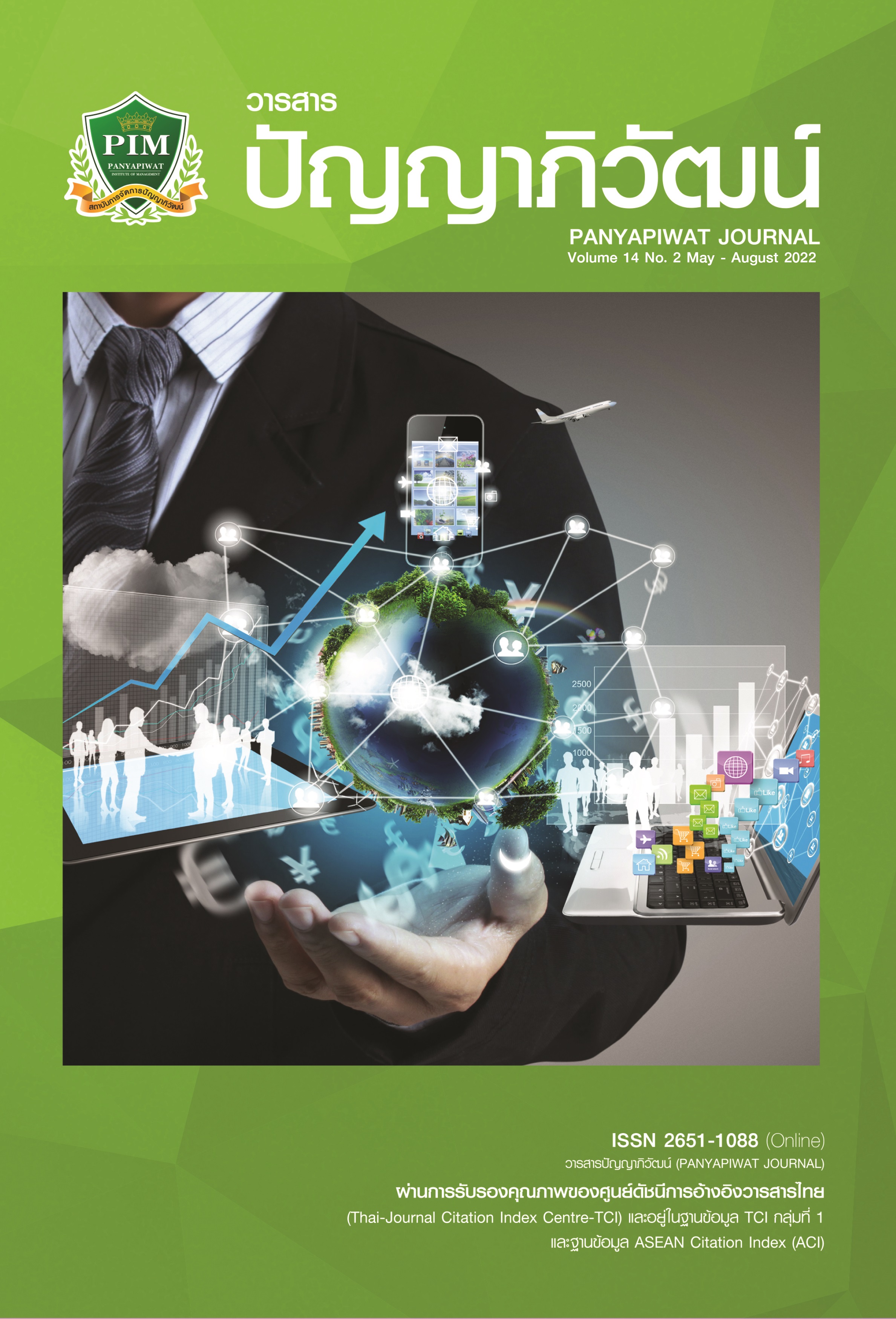APPLICATION OF THE INFORMATION TECHNOLOGY IN AUTOMOTIVE INDUSTRY IN THE EASTERN REGION OF THAILAND
Main Article Content
บทคัดย่อ
This article is aimed at studying the application of logistics and supply chain information technology in the automotive industry in the Eastern Region of Thailand and analyzing guidelines for corporate information technology development to support the connection and exchange of data in the organization. This is a qualitative research. Research data were obtained from studying the documents and conducting semi-structured interviews with the people involved with the development or management work for application of the corporate information technology. According to the research result, it was found that the workplaces had emphasized the application of information technology at an operational level aiming at automatic operation of works and had emphasized the use of technologies for monitoring and control of parts or products but still lacked the connection of data between departments within the company; whereas, at present, the application of information technology which was modern and prepared for development at the utmost efficiency but the personnel still lacked skills for utilization of information technology to increase the operational potentials of the company. In this research, guidelines for application of information technology have been proposed for connection of correct and up-to-date corporate information.
Article Details

อนุญาตภายใต้เงื่อนไข Creative Commons Attribution-NonCommercial-NoDerivatives 4.0 International License.
“ข้าพเจ้าและผู้เขียนร่วม (ถ้ามี) ขอรับรองว่า บทความที่เสนอมานี้ยังไม่เคยได้รับการตีพิมพ์และไม่ได้อยู่ระหว่างกระบวนการพิจารณาลงตีพิมพ์ในวารสารหรือแหล่งเผยแพร่อื่นใด ข้าพเจ้าและผู้เขียนร่วมยอมรับหลักเกณฑ์การพิจารณาต้นฉบับ ทั้งยินยอมให้กองบรรณาธิการมีสิทธิ์พิจารณาและตรวจแก้ต้นฉบับได้ตามที่เห็นสมควร พร้อมนี้ขอมอบลิขสิทธิ์บทความที่ได้รับการตีพิมพ์ให้แก่สถาบันการจัดการปัญญาภิวัฒน์หากมีการฟ้องร้องเรื่องการละเมิดลิขสิทธิ์เกี่ยวกับภาพ กราฟ ข้อความส่วนใดส่วนหนึ่งและ/หรือข้อคิดเห็นที่ปรากฏในบทความข้าพเจ้าและผู้เขียนร่วมยินยอมรับผิดชอบแต่เพียงฝ่ายเดียว”
เอกสารอ้างอิง
Ageron, B., Bentahar, O., & Gunasekaran, A. (2020). Digital supply chain: Challenges and future directions. Supply Chain Forum: An International Journal, 21(3), 133-138.
Aktas, E., Agaran, B., Ulengin, F., & Onsel, S. (2011). The use of outsourcing logistics activities: The case of Turkey. Transportation Research Part C: Emerging Technologies, 19(5), 833-852.
Aljazzar, S. M., Jaber, M. Y., & Moussawi-Haidar, L. (2017). Coordination of a three-level supply chain (supplier-manufacturer-retailer) with permissible delay in payments and price discounts. Applied Mathematical Modeling, 48, 289-302.
Bowersox, D. J., Closs, D. J., & Cooper, M. B. (2013). Supply chain logistics management. McGraw-Hill.
Chen, L., Zhao, X., Tang, O., Price, L., Zhang, S., & Zhu, W. (2017). Supply chain collaboration for sustainability: A literature review and future research agenda. International Journal of Production Economics, 194, 73-87.
Demeeter, K., & Golini, R. (2014). Inventory configurations and drivers: An international study of assembling industries. International Journal of Production Economics, 157, 62-73.
Gunasekaran, A., Subramanian, N., & Papadopoulos, T. (2017). Information technology for competitive advantage within logistics and supply chains: A review. Transportation Review, 99, 14-33.
Gupta, M., & Kohli, A. (2006). Enterprise resource planning systems and its implications for operations function. Technovation, 26(5-6), 687-696.
Kasikorn Research Center. (2020). FTA backs automotive industry, establishing links to global supply chains and boosting cars and auto parts exports and investment. http://www.tpso.moc.go.th/sites/default/files/tpso_journal_mar_64_issue_116.pdf
Kergroach, S. (2019). National innovation policies for technology upgrading through GVCs: A cross-country comparison. Technological Forecasting and Social Change, 145, 258-272.
Kim, M., & Chai, S. (2017). The impact of supplier innovativeness, information sharing and strategic sourcing on improving supply chain agility: Global supply chain perspective. International Journal of Production Economics, 187, 42-52.
Lambert, D. M., & Enz, M. G. (2017). Issues in supply chain management: Progress and potential. Industrial Marketing Management, 62, 1-16.
Li, X. (2014). Operations management of logistics and supply chain issues and directions. Discrete Dynamics in Nature and Society, (2), 1-7.
Liao, S. H., Hu, D. C., & Ding, L. W. (2017). Assessing the influence of supply chain collaboration value innovation, supply chain capability and competitive advantage in Taiwan’s networking communication industry. International Journal of Production Economic, 19, 143-153.
Makkonen, H., & Mervi, V. (2014). The role of information technology in strategic buyer-supplier relationships. Industrial Marketing Management, 43(6), 1053-1062.
Minkyun, K., & Chai, S. (2016). The impact of supplier innovativeness, information sharing and strategic sourcing on improving supply chain agility: Global supply chain perspective. International Journal of Production Economic, 187, 42-52.
Moons, K., Waeyenbergh, G., & Pintelon, L. (2019). Measuring the logistics performance of internal hospital supply chains-a literature study. Omega, 82, 205-217.
Nagurney, A., & Li, D. (2015). A supply chain network game theory model with product differentiation, outsourcing of production and distribution, and quality and price competition. Annals of Operations Research, 226(1), 479-503.
Ogden, J. A. (2006). Supply base reduction: An empirical study of critical success factors. Journal of Supply Chain Management, 42(4), 29-39.
Pham, H. C., Nguyen, T. T., Mcdonald, S., & Tran-Kieu, N. Q. (2019). Information sharing in logistics firms: An exploratory study of the Vietnamese logistics sector. The Asian Journal of Shipping and Logistics, 35(2), 87-95.
Prajogo, D., & Olhager, J. (2012). Supply chain integration and performance: The effects of long-term relationships, information technology and sharing, and logistics integration. International Journal of Production Economics, 135, 514-522.
Saban, K., Mawhinney, J. R., & Drake, M. J. (2017). An integrated approach to managing extended supply chain networks. Business Horizons, 60(5), 689-697.
Shah, R., & Ward, P. T. (2007). Defining and developing measures of lean production. Journal of Operations Management, 25(4), 785-805.
Skippari, M., Laukkanen, M., & Salo, J. (2017). Cognitive barriers to collaborative innovation generation in supply chain relationships. Industrial Marketing Management, 62, 108-117.
Sousa, R. T., Liu, S., Papageorgiou, L. G., & Shah, N. (2011). Global supply chain planning for pharmaceuticals. Chemical Engineering Research and Design, 89(11), 2396-2409.
Trade Policy and Strategy Office. (2021). Trade policy and strategy office journal for March 2021. http://www.tpso.moc.go.th/sites/default/files/tpso_journal_mar_64_issue_116.pdf [in Thai]
Yongpisanphob, W. (2020). Industry outlook 2020-2022: Auto parts industry. Krungsri. https://www.krungsri.com/en/research/industry/industry-outlook/Hi-tech-Industries/Auto-Parts/IO/Industry-Outlook-Auto-Parts
Zhou, H., & Benton, W. C. (2007). Supply chain practice and information sharing. Journal of Operations Management, 25(6), 1348-1365.


